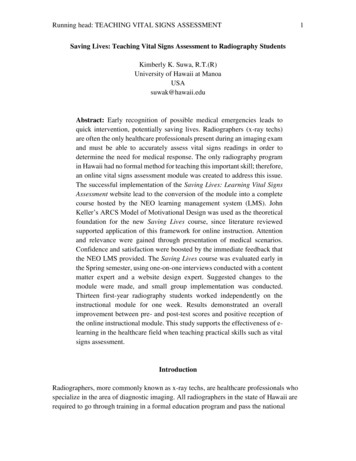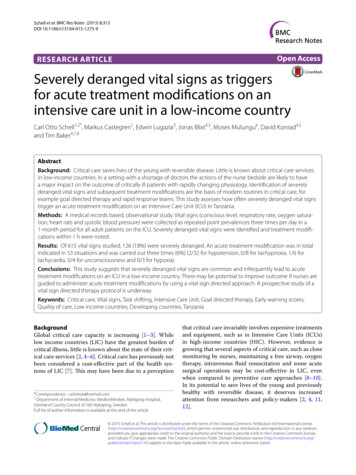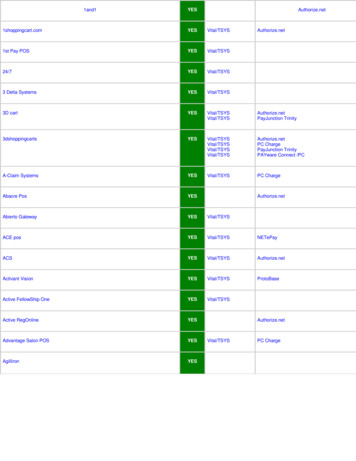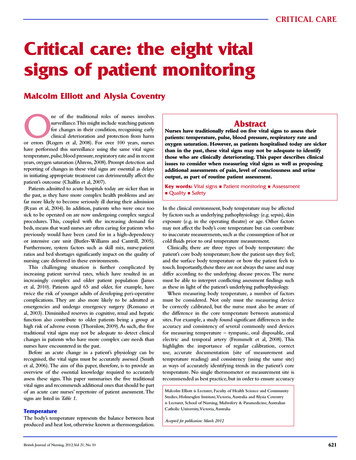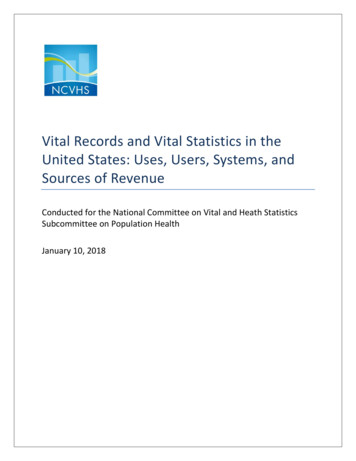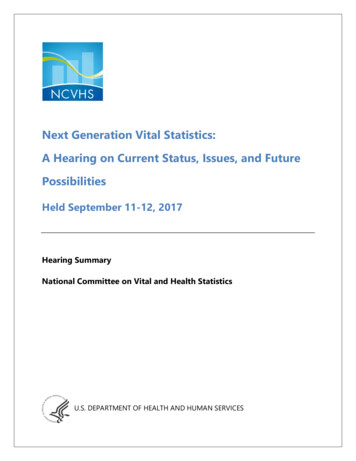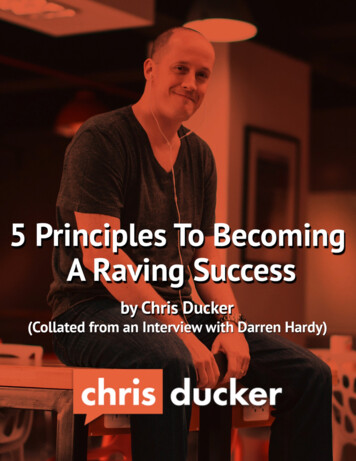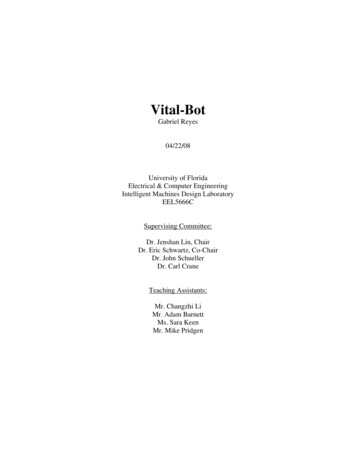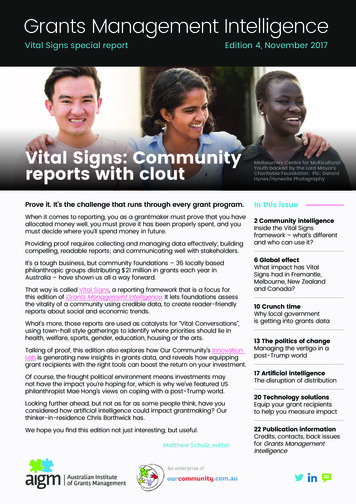
Transcription
Grants Management IntelligenceVital Signs special reportEdition 4, November 2017Vital Signs: Communityreports with cloutProve it. It's the challenge that runs through every grant program.When it comes to reporting, you as a grantmaker must prove that you haveallocated money well, you must prove it has been properly spent, and youmust decide where you’ll spend money in future.Providing proof requires collecting and managing data effectively; buildingcompelling, readable reports; and communicating well with stakeholders.It’s a tough business, but community foundations – 36 locally basedphilanthropic groups distributing 21 million in grants each year inAustralia – have shown us all a way forward.That way is called Vital Signs, a reporting framework that is a focus forthis edition of Grants Management Intelligence. It lets foundations assessthe vitality of a community using credible data, to create reader-friendlyreports about social and economic trends.What's more, those reports are used as catalysts for “Vital Conversations”,using town-hall style gatherings to identify where priorities should lie inhealth, welfare, sports, gender, education, housing or the arts.Talking of proof, this edition also explores how Our Community’s InnovationLab is generating new insights in grants data, and reveals how equippinggrant recipients with the right tools can boost the return on your investment.Of course, the fraught political environment means investments maynot have the impact you’re hoping for, which is why we’ve featured USphilanthropist Mae Hong’s views on coping with a post-Trump world.Looking further ahead, but not as far as some people think, have youconsidered how artificial intelligence could impact grantmaking? Ourthinker-in-residence Chris Borthwick has.We hope you find this edition not just interesting, but useful.Matthew Schulz, editorMelbourne's Centre for MulticulturalYouth backed by the Lord Mayor'sCharitable Foundation. Pic: GerardHynes/Hynesite PhotographyIn this issue2 Community intelligenceInside the Vital Signsframework – what’s differentand who can use it?6 Global effectWhat impact has VitalSigns had in Fremantle,Melbourne, New Zealandand Canada?10 Crunch timeWhy local governmentis getting into grants data13 The politics of changeManaging the vertigo in apost-Trump world17 Artificial intelligenceThe disruption of distribution20 Technology solutionsEquip your grant recipientsto help you measure impact22 Publication informationCredits, contacts, back issuesfor Grants ManagementIntelligence
The Vital Signs framework has been adopted by community foundations across the globe.ô Community intelligenceHow Vital Signs is sparking newlife in communitiesBy Matthew Schulz, journalist, Our CommunityFirst conceived in Toronto in 2001, anddeveloped by Community FoundationsCanada (CFC) in 2006 into a nationalprogram there, Vital Signs has spread to 85Canadian communities, and communitiesacross the world, and now it has a footholdin Australia.The reporting framework is intended for useby community foundations, but the results arealso providing lessons for governments andgrantmakers of all shapes and sizes.Melbourne, Ballarat and Fremantle are threeAustralian cities that have used Vital Signs asa community health check, but many more arelooking carefully at the model.Australian Community Philanthropy supports thesystem for community foundations in Australia.It is licensing the use of the Vital Signs systemfor 500– 1000 per foundation, which goes todeveloping the program and resources here,but most of the tools for the service are free foranyone to use.Executive officer Kate Buxton says Vital Signs“connects the dots of data” for “understanding,engagement and response” to create insights forgrantmakers, but also the rest of the community.She says foundations are using Vital Signs toleverage their two big assets: endowments and“deep local knowledge” to improve the way theydisburse funds and increase their influence.While Vital Signs is still new to many in Australia,Ms Buxton expects many more of the country’sfoundations – many in rural and regional areas –will adopt the system.What’s different about Vital Signs?One of the big selling points of Vital Signs is itstarget of civic engagement, creating a focus forpublic debate via easy-to-read reports that feedinto “community conversations” about big issuessuch as unemployment or the environment.Those conversations take place with residents,businesses, community groups, universities, andcommunity leaders.In turn, those conversations can generate newpriorities and media coverage.Grants Management IntelligenceNovember 20172
Community foundations place themselves at thecentre of the process to: Set strategic priorities Inform community grants Guide donor and community engagement Create conversations with leaders and partners Generate public awareness and attention.While we’ve all developed evaluation methods,Vital Signs has at its centre the concepts ofsharing resources, adapting existing data, andusing community knowledge.For instance, Vital Signs reports here would beexpected to draw on credible data available fromthe ABS, universities or governments.Vital Signs uses that data to spell out the state ofaffairs for geographic communities with a set ofmeasures that matter for that local community.What’s more, the method can connect local effortswith global aims. Foundations have the option tolink to the UN’s 17 sustainable development goals –from ending poverty and hunger, to creating jobsand a better environment.Does size matter when it comes toVital Signs?Community Foundations of Canada (CFC)president Ian Bird, in Melbourne recently for theNational Community Foundations Forum, says VitalSigns can benefit an entire community.He told Grants Management Intelligence that VitalSigns had worked as well in small communitiesas in cities, if not better, because levels ofengagement were higher and getting attentioncan be easier without competition from the“clutter” of cities.He says communities had gotten involved for aslittle as 2000, supported by an “open platform”approach by CFC, backed by free webinars andother resources.Key ingredients for success with Vital Signsinclude: Dedicating at least six months of concentratedeffort to the project Engaging partners, including qualifiedresearchers and community leaders Submitting a participation agreement inAustralia Establishing an advisory committee Identifying key issues Conducting consultation Developing your communication strategy Developing your data and indicators Generating surveys if needed Implementing community engagement postrelease.Vital Signs:An introductionWhat is it?Vital Signs is a reporting framework that usescommunity knowledge to measure the vitalityof communities, by first gathering credibleand reliable data, then publishing readerfriendly reports on that community’s socialand economic trends.What is it used for?The reports on such issues as poverty,education, unemployment and theenvironment help the community foundationswho’ve commissioned them to sparkconversations with local authorities, anddecide where to focus their resources andgrants to have the biggest impact. Thereports are also used to drive policy andchange at local, national and global levels.Who uses it?The Vital Signs system, developed inCanada, is primarily designed to be usedby community foundations to enable themto engage with citizens and stakeholderson the big issues. Foundations encouragepartnerships with governments, educationinstitutions, funders and service providers –including in the production of reports.Who else could use it?Any community foundation in the worldcan get access to the Vital Signs resourcesthrough both Australian CommunityPhilanthropy and Community Foundations ofCanada.At this stage, the Canadian originators ofVital Signs haven’t created any products fororganisations that aren’t foundations, but saythey are open to the possibilities.However, any place-based grantmaker – thatis, any grantmaker focused on a geographicarea, such as a local government grantmaker– could adopt the same broad approach asVital Signs: that is, use reliable data to informyour funding decisions, and form partnershipsto solve problems.Grants Management IntelligenceNovember 20173
How big should your report be?The package comprises the Vital Conversation,Vital Brief, Vital Focus and Vital Signs main report.But organisations are allowed to create their ownspin on those elements – for example, MomentumWaikato’s Vital Impact Programme (see pg8).Mr Bird attributes part of the success of Vital Signsin Canada to the fact that foundations had pooledresources (about 1000–2000 per foundation) tohelp generate data, then analysed it centrally.He says it’s a demonstration that organisationscan scale the size of their study to match theirbudgets.For example, smaller organisations can start on asingle topic, whether sport, health, or welfare.“Vital Signs provides your community with theopportunity to take the pulse, and to see togetherwhat’s really going on.What’s working, what’s not working. It breaks itdown into specific issues. You can look at arts andculture, you can look at health and wellbeing, youcan look at economic equality,” Mr Bird says.“It allows your community to assess and prioritisewhere they ought to put their resources, theirtime and their attention to make for a more vitalcommunity.”Something you can read on the busMr Bird told the forum Vital Signs provided “streetlevel” knowledge that could shape grantmaking,development goals and strategies, yet while areport created a snapshot, its true value was “inthe everyday”.Community Foundations of Canada president Ian Birdsays foundations can make a significant impact witha relatively small outlay. Picture: Andrea DicksVital Signs users who had “flourished” had been theones who considered how the report’s implicationswould “play out over the next 52 weeks”, or evenover spans of two or three years.Outside the session, Mr Bird said: “In today’s busyworld, you’ve got lots of activities going in all sortsof directions, but if you take on Vital Signs youget this chance for alignment and can build astrategy to address those concerns”.Unlocking those insights was partly achieved withpartnerships, he said.The Fremantle Foundation report is typical of the easy-to-read Vital SIgns format.Grants Management IntelligenceNovember 20174
The Fremantle Foundation’s Vital Signs report showed a need for better inclusion, diversion and engagementfor youth, and the result is a 100,000 grant for its Night Hoops program and its Saturday night basketballtournaments. Picture: Jean-Paul HorréHe gave the example of a small community inthe state of Manitoba in central Canada thathad chipped in 10,000 to produce the report,and created a partnership with a local college toenable a skilled researcher to get involved.Using researchers from recognised institutions –such as universities – meant that organisationswould be far more able to “produce credible data”.“So much of the data is tucked away in anacademic sense you need professional help toget it out and make it freely available”.In the same way, organisations were encouragedto develop a communications plan that involvedpackaging information and partnering with localmedia to get the message out.“People should be able to read a Vital Signs reporton the bus; it should make sense to them,” Mr Birdsaid.What’s the role of other authorities?Asked why organisations wouldn’t just turn to localgovernment studies or the ABS for this kind ofinformation, Ms Buxton said Vital Signs “isn’t justabout where we’re sitting, but why, and how wecan respond”.“Councils may have reports and data, but whatVital Signs does is look behind the data to thestory. And the way of creating the report – thewhole engagement process – is just as important.”“Even if you’ve got data coming out of your ears,Vital Signs provides something else.”That process of talking with a community – whichmay be very small – can help generate a muchbetter understanding of needs than just anotherstudy, she says.Importantly, community foundations couldplace themselves as a “neutral broker” outsidethe normal politics to host those conversations,while harnessing resources that governmentscouldn’t – such as connections with otherphilanthropic supporters and donors.For instance, the Momentum Waikto projectmentioned earlier generated a broad study withgreat community engagement, with the backing ofother philanthropic partners.But Ms Buxton stresses local and other levels ofgovernment are able to take advantage of thereports, because data is in an accessible form,unlike the often “dense” official demographicstudies.This had been the experience in Canada, wherecouncil equivalents were “relying heavily” on thework of foundations, she says.CFC says it is open to the evolution of Vital Signs,as interest grows from organisations that aren’tfoundations. But while partnerships with mediaand tertiary institutions are often crucial to thesuccess of reports, so far the focus has beenon it being a philanthropic tool to better informgrantmaking and priorities.Grants Management IntelligenceNovember 20175
'If Melbourne was 100 people .' in Greater Melbourne Vital Signs 2017 typifies the quick-fire summary approach.ô Community intelligenceWhat impact can Vital Signs have?By Matthew Schulz, journalist, Our CommunityMelbourne shines a light on issuesAt the National Community FoundationsForum in Melbourne, Australia’s biggestcommunity foundation, the Lord Mayor’sCharitable Foundation, launched its VitalSigns 2017 report to strong public interest.“Melbourne is vibrant and culturally diverse, andGreater Melbourne Vital Signs 2017 has taken thepulse,” Foundation chief Catherine Brown says.Ms Brown says Vital Signs allows foundations to“leapfrog your capability” by using the processes,design and data methods already developed byothers globally.In future, Australian cities and regions would beable to compare their data sets on education,health and other topics to create an even morepowerful tool.Critically, Ms Brown says, the report doesn’t try todisplay everything in glowing terms.“As Melburnians, we have great things to celebratesuch as our city’s sport and arts culture, education,healthcare and stability; however, we need to keepworking on issues such as reducing homelessness,discrimination; increasing employmentopportunities for young people; and ensuring wework on creating sustainable food systems.”Data for the report, as for other Vital Signs studies,has been collected from a wide range of sourcesincluding the 2016 Census, the Victorian PopulationHealth Survey 2015, federal and state governmentdepartment research reports, the Bureau ofMeteorology and the CSIRO.Ms Brown told the forum Vital Signs haddemonstrated “a very practical impact”, includingthe foundation’s decision to appoint separateproject managers for topic areas.“It’s been a wonderful tool and we expect that wewill use it more.”Lord Mayor’s Charitable Foundation CEO CatherineBrown says adopting the Vital Signs framework allowedthe organisation to “leapfrog” its capabilities by usingprocesses that have already been developed.Grants Management IntelligenceNovember 20176
Ms Brown said the Lord Mayor’s CharitableFoundation relied on existing data from 96 sourcesincluding the ABS, but Vital Signs enabled thefoundation to gain local insights from the data, topresent them in a digestible way, and to identifytrends.“This way people can see trends and big issues –and making it accessible is a very big part of it.”Ms Brown says the Vital Signs report has “madea big difference to us”, particularly in the way ittackled the big issues facing Melbourne, and saysthe resource was “much more valuable” once itwas being used by other people.But despite the helpful template, she stresses thatVital Signs is no “cookie cutter”, and each town,city or region is required to adapt a different set ofdata based on its needs.In a comment piece published soon after theevent, she said: “This local self-help approachwhich community foundations embody is wellunderstood within the community foundationmovement around the world. Using a collectiveapproach to tackle local challenges faced atany particular time has been proven to make adifference in many communities, from Melbourneto New Orleans.”Fremantle’s report sparked changeWhere the Melbourne project drew on theresources of a well-endowed foundation, theFremantle Foundation’s Vital Signs report wasproduced as a “bootstrapped” 30,000 project.It was streamlined as much as possible anddrew on the academic resources of the Centrefor Social Impact at the University of WA and theUniversity of Notre Dame.Fremantle Foundation CEO Dylan Smith says the VitalSigns concept should work in the same way a smalltown keeps an eye out for trouble, and steps in to help.Foundation chief Dylan Smith said the effort hadbeen well worth it, “aligning community needswith the available resources”, but also sparkingsignificant debate in his community.“There’s no document that better demonstratesour role in the community,” Mr Smith said.Mr Smith drew comparisons between the reportand his upbringing in small-town Victoria, wherethe sense of community meant everyone was alertto the “signs” of trouble, or simply change.He cited the example of his dad’s brokendown car being spotted on the roadside, whichJess is among the Fremantle Foundation stories in its report, highlighting the benefits of weekly cookingclasses which won a 100,000 grant from the organisation. Picture: Jean-Paul HorréGrants Management IntelligenceNovember 20177
Waikato consulted widely on their report, before embarking on a 1m grants program. Picture: Ruth Gilmourprompted half a dozen townsfolk to offer repairs,school pickups and other help by the day’s end.In the same way, the Fremantle Vital Signs report– distributed through the local newspaper andpromoted with a 150 Facebook advert – wassimple for locals to digest, or as Mr Smith put it,“something you could read on the bus”.Yet for its simplicity, it combined hard data withcompelling stories – images and stories aboutcooking classes, a homework club, and matessupporting mates – to illustrate the work beingdone in “Freo” on disadvantage, education andmental health.Among the report’s unexpected findings was thatwithin Freo’s wealth, there were significant “pocketsof real disadvantage”. This came as a shock tosome stakeholders, but the foundation, like itsMelbourne equivalent, refused to whitewash theissues.As a result, the report served as a starting pointthat drew the mayor, donors, supporters and thecommunity into asking the question: “If Fremantlecould speak, what would it say?”Kiwi community aims for big impactWaikato in New Zealand’s north – throughMomentum Waikato, the region’s communityfoundation – has gone further than most inadapting Vital Signs to suit the region’s needs.It developed its plan for a NZ1 million grantsprogram based on ten community prioritiesit highlighted during a brainstorming sessioninvolving 400 people in four towns.Better community connection and improvededucation for youth were the top two prioritiesagreed, and the foundation targeted “inspirational”and “transformational” projects for funding in a“Vital Impact Programme” (VIP) including: A healthy school lunches project for 10 schools A partnership that aims to plant 80 millionnative trees to improve local waterways A street youth work program for the city ofHamilton that aims to cut crime by 20% andcreate jobs.While the foundation wasn’t going to take allthe credit, it could certainly claim a hand in thecouncil’s decision to proceed with a homelessnessproject, Mr Smith said.Either way, it had given the foundation a chanceto broaden the usual chatter with donors – andwould-be donors – about ancilliary funds, orreporting requirements, he said.As Mr Smith put it, “you’re building the socialinfrastructure that’s needed for change.”Watch: Momentum Waikato's Vital Impact Programme.Grants Management IntelligenceNovember 20178
Momentum Waikato developed VIP with threecomponents: the Vital Waikato Fund, WaikatoVital Signs and Vital Waikato Grant. The CFCencourages this type of flexibility.Momentum Waikato’s Gemma Slack describesthe VIP approach as collective community impact,allowing “anyone in our region to make a gift to thefund, which is then pooled for grants”.And significantly, those grants are determinedbased on the needs and aspirations identifiedfrom the Vital Signs project.Ms Slack says findings from Vital Signs were alsopresented to local councils, “who have used thereport to inform decision making in strategicplanning”.Watch: Ian Bird and Dylan Smith on Vital Signs.A separate funder, WEL Energy Trust, used thesame findings to establish a new NZ400,000grant to target housing.In response, Centre Wellington’s foundationcreated a network to help guide the region’s artsand culture program.How Canada is reading the signsCentre Wellington’s Erin Pratley – in Australiato help develop the program here – says thefoundation has used the report to highlight tograntseekers the kinds of programs it’s morelikely to fund, to build connections with localgovernment, and to extend its communityoutreach.The same pattern of information, conversation andaction has played out in similar ways in Canadafor more than a decade.For example, take the Youth Catalyst Fund grantsprogram, which ran in 2015–2016 in response toyouth unemployment issues uncovered in theCommunity Foundations of Canada 2012 VitalSigns report #GenerationFlux.The program saw C1.2 million in high-impactgrants to organisations across Canada, followedby C 1 million in impact investments in socialenterprises across Ontario.Another Canadian study by the small communityof Centre Wellington in southern Ontario highlightsthat the benefits of Vital Signs go beyond thedistribution of cash.For example, its study found there was greatpotential for arts and culture industries in thecommunity, but that activity was disparate acrosshundreds of events.But many other organisations are now relyingon the Centre Wellington Vital Signs findings toapply for grants elsewhere, and develop their owncommunity programs.“They use it because of the specific local data itcontains and because it has an authority to it thatother sources may not,” Ms Pratley says.The “open data” approach at the heart of VitalSigns is also something for all grantmakers toconsider, a method that can shine a light on acommunity’s priorities, and make the informationfree for government, the private sector and notfor-profits.MORE RESOURCESVideo: Ian Bird, Dylan Smith talk Vital SignsAIGM help sheets: Program evaluation Sharing the lessons learnedAIGM report: Kate Buxton on communityfoundations in AustraliaBackgrounder: Australian roll-outWatch now: How Winnipeg in south-centralCanada produced its Vital Signs study.Vital signs reports: Melbourne micro site Fremantle Ballarat Vital Signs Canada Momentum Waikato Centre WellingtonGrants Management IntelligenceNovember 20179
Innovation Lab Director of Data Intelligence Sarah Barker says data can increase impact and reduce waste.M Data intelligenceWhy it’s crunch timefor local governmentBy Matthew Schulz, journalist, Our CommunityOur Community's Innovation Lab isgenerating new insights in grants data, andlocal government grantmakers have beenquick to show interest.While the food and drinks were great at therecent Local Government Muster, held at aninner-city Melbourne eatery, it was the prospectof serious data crunching that had grantmakersbuzzing with possibilities at the event hosted bythe Australian Institute of Grants Management.In particular, the prospect of being able to shareand benchmark grantmaking performanceagainst other councils saw people's ears prickup, as the Innovation Lab Director of DataIntelligence, Sarah Barker, spelt out the rolloutof CLASSIE and new data features onto theSmartyGrants platform, the Our Communitygrants management system.Fourteen organisations were represented, but itwas grantmakers from among the 49 Victoriancouncils already using SmartyGrants who weremost enthusiastic.Ms Barker explained how organisations canleverage their information to increase impactand reduce waste, by showing how they can usethe SmartyGrants dashboard and CLASSIE, theclassification system for social sector initiativesand entities.Mrs Barker showed how councils (and othergrantmakers) can use the dashboard to see: Application indicators such as approval ratesand submission rates What is being funded (CLASSIE "subjects") Who the recipients are (CLASSIE "populations")SmartyGrants is developing capabilities to displaylive benchmarks. Ms Barker presented graphs ofkey interest and demographic groups, the relativespending in different program areas, and grantapproval and submission rates, to demonstratehow benchmarks might be used."You might have a submission rate of 77%. Is thatgood or bad? It can be useful to know how youcompare to other grantmakers," Ms Barker said.Lower submission rates, for instance, coulddemonstrate there were problems with guidelines,forms or timelines. Mapping functions beingdeveloped would allow grantmakers to see wherefunds were being directed, by applicant addressor by project locations.Future functions would include the abilityto overlay other data over maps, includingpopulation, socioeconomic and remotenessinformation.In line with the Our Community motto that insightsmust be "useful and not just interesting", Ms Barkersaid, "SmartyGrants will continue to make it easierGrants Management IntelligenceNovember 201710
for grantmakers to see where the money is going,compare themselves to similar organisations (forexample, by CLASSIE "organisation type" and size)and compare similar programs. This will open upopportunities to collaborate and learn from eachother."Those tools of course will be more effective asmore councils make use of the CLASSIE system,using a common "language" across the sector.City of Glen Eira community development officerBeverley Rayner said after the session thatcouncils had an obligation to make better use ofavailable data."I think the risk is that you're not aware of howyou're distributing your money with your grants,you're not looking at your strategic direction, andyou're not looking at what you have, how you'resupporting your local community and how italigns with that strategic direction."City of Greater Dandenong community fundingteam leader Gavin Murphy said that withoutmaking use of the data available, organisationsrisked failing to properly meet the communityneed."While as a grantmaker you may have a gutfeeling about where the grants aren't comingfrom, that's a really hard thing to explain topeople – and say you need invest in resources.When you've got the data to back it up theneveryone's going to say yes."The City of Greater Dandenong was in theprocess of migrating to the SmartyGrants system,and intended to create data sets specific to theneeds of Melbourne's southeast."We're seeking to collect data that's really relevantto our community and what we want to measure,"Mr Murphy said.Mr Murphy said the uses of that data includedbeing able to locate the source of unsuccessfulapplications, whether that's by geography ordemography, enabling the council to considerincreasing resources to reach out to thosecommunities."That's how I see the data being used more thananything. To see where our gaps are, to thenspend time and resources to address thoseneeds," he said.Knox Council community resourcing officer DebRobert said her organisation was also gearing upto make better use of the system."We're certainly very keen to document, to getas much out of our data that we're collectingthrough grants as possible. And we know there'sCity of Glen Eira community development officerBeverley Rayner says there are risks of not using thedata at your disposal. Picture: Matthew Schulza lot of really valuable stories to tell in all thatgrants information."Ms Roberts had high hopes for how SmartyGrants,and CLASSIE, would be able to help organisationsclarify what they were doing with data. She saideveryone needed to be clear with their purpose."SmartyGrants as a leader in the field is in a goodposition to have that overview, which can helpguide the purposes which the data can best beput to."City of Port Phillip grants and community projectsofficer Trishula Nagarajan said she was quicklylearning the significance of the use of data in herrelatively short time at the bayside council."Data is integral. It's is the new language. All thedecisions are made based on data. Council hasmade a great investment with SmartyGrantsand it sounds like there's some really interestingdevelopments and I'm excited to see what's tocome."MORE RESOURCESAbout CLASSIE The Innovation Lab Video:How grantmakers want to make data workAIGM help sheets: Record keeping Performance measurementGrants Management IntelligenceNovember 201711
Yes!SmartyGrants equityadvisor Olly says yourapproval makes allthe differenceJoin the SmartGrants revolutionwww.smartygrants.com.auSoftware & data sciencefor revolutionary grantmakers
6 PhilanthropyGrantmakers’ role in the globalbattle against inequalityBy Matthew Schulz, journalist, Our CommunityLeading US philanthropist Mae Hong saysglobal political turmoil is a wake-up call forfunders with the power to push for change.The Vice President of Rockefeller PhilanthropyAdvisors (RPA) says philanthropists in particularhad become the “guardians of good”, and faceda battle like no other to hold the line againstpowerful forces eroding civil society.But Ms Hong says her stark appraisal – in the wakeof Donald Trump’s election and the rise of populistauthoritarians – should no longer be a shock tothose working in the field.Ms Hong recently visited Australia as a gu
That way is called Vital Signs, a reporting framework that is a focus for this edition of Grants Management Intelligence. It lets foundations assess the vitality of a community using credible data, to create reader-friendly reports about social and economic trends. What's more, those reports are used as catalysts for "Vital Conversations",
